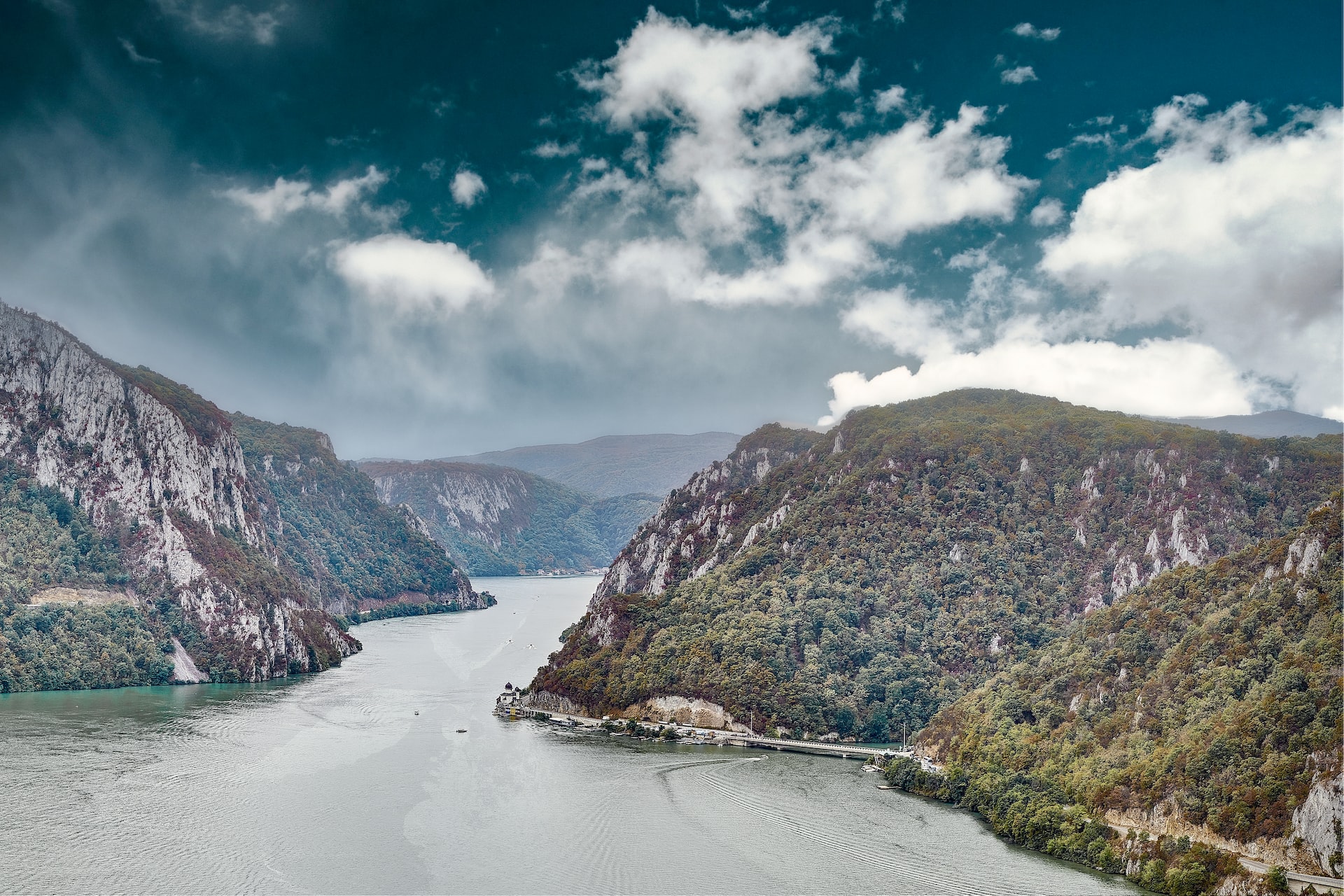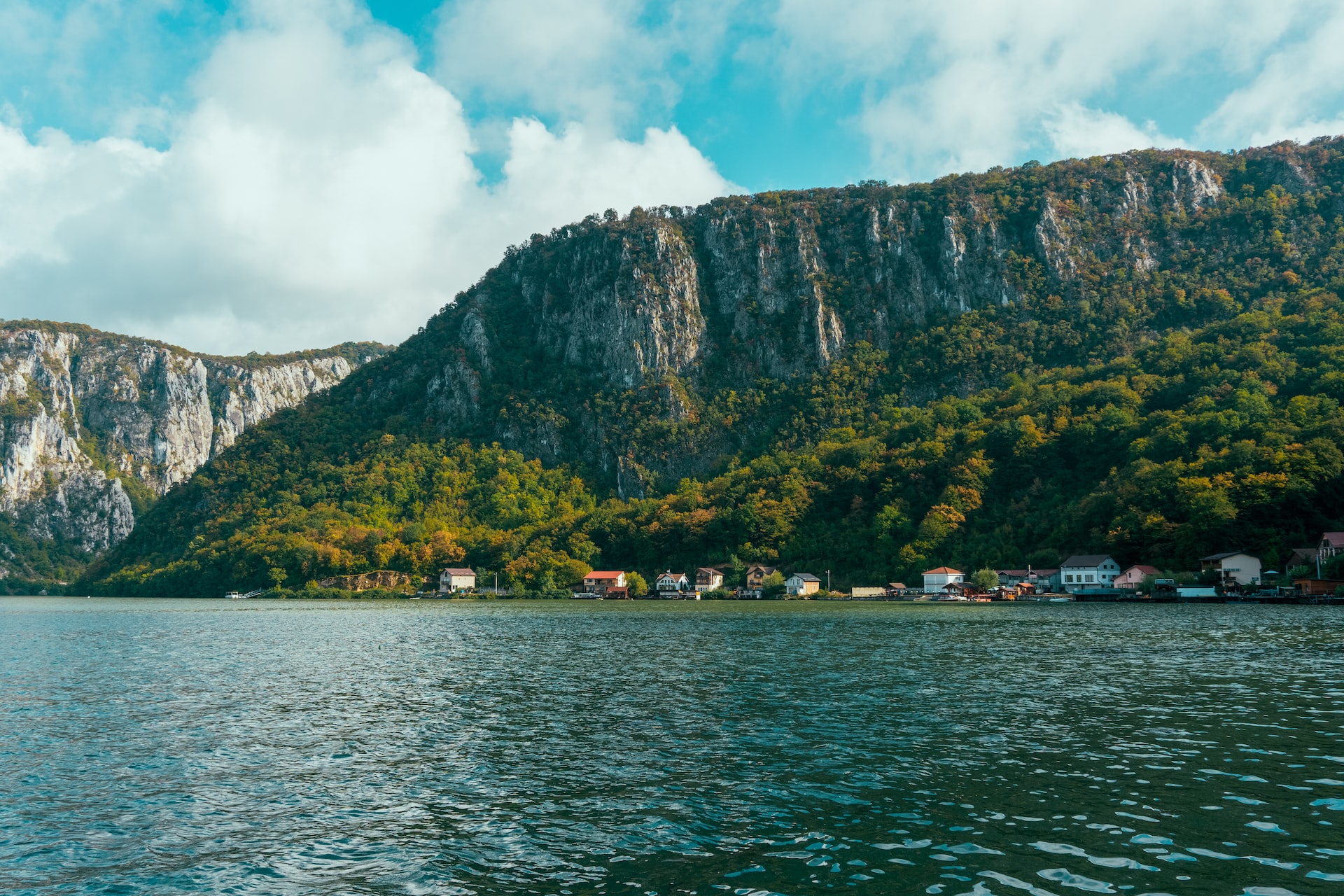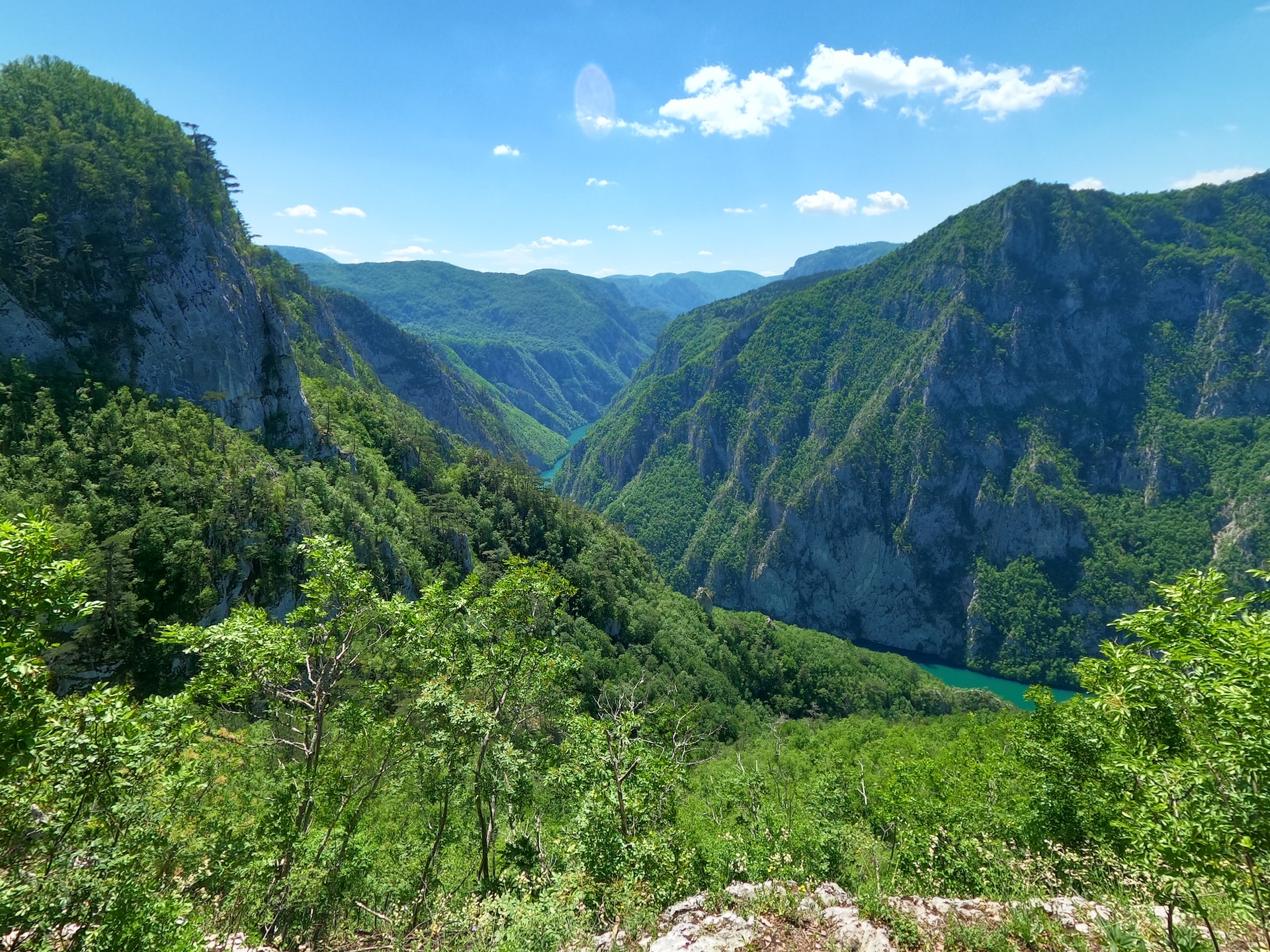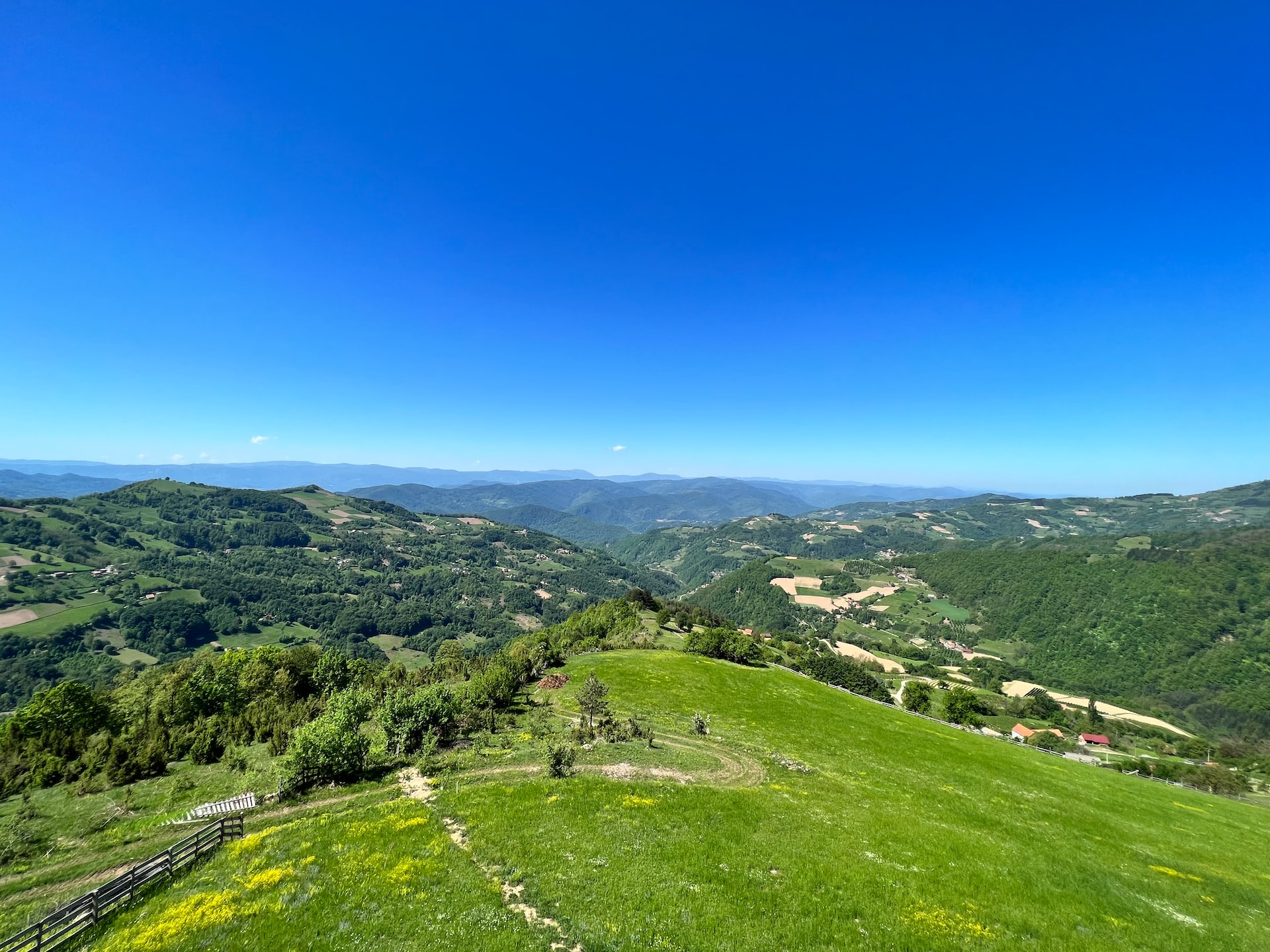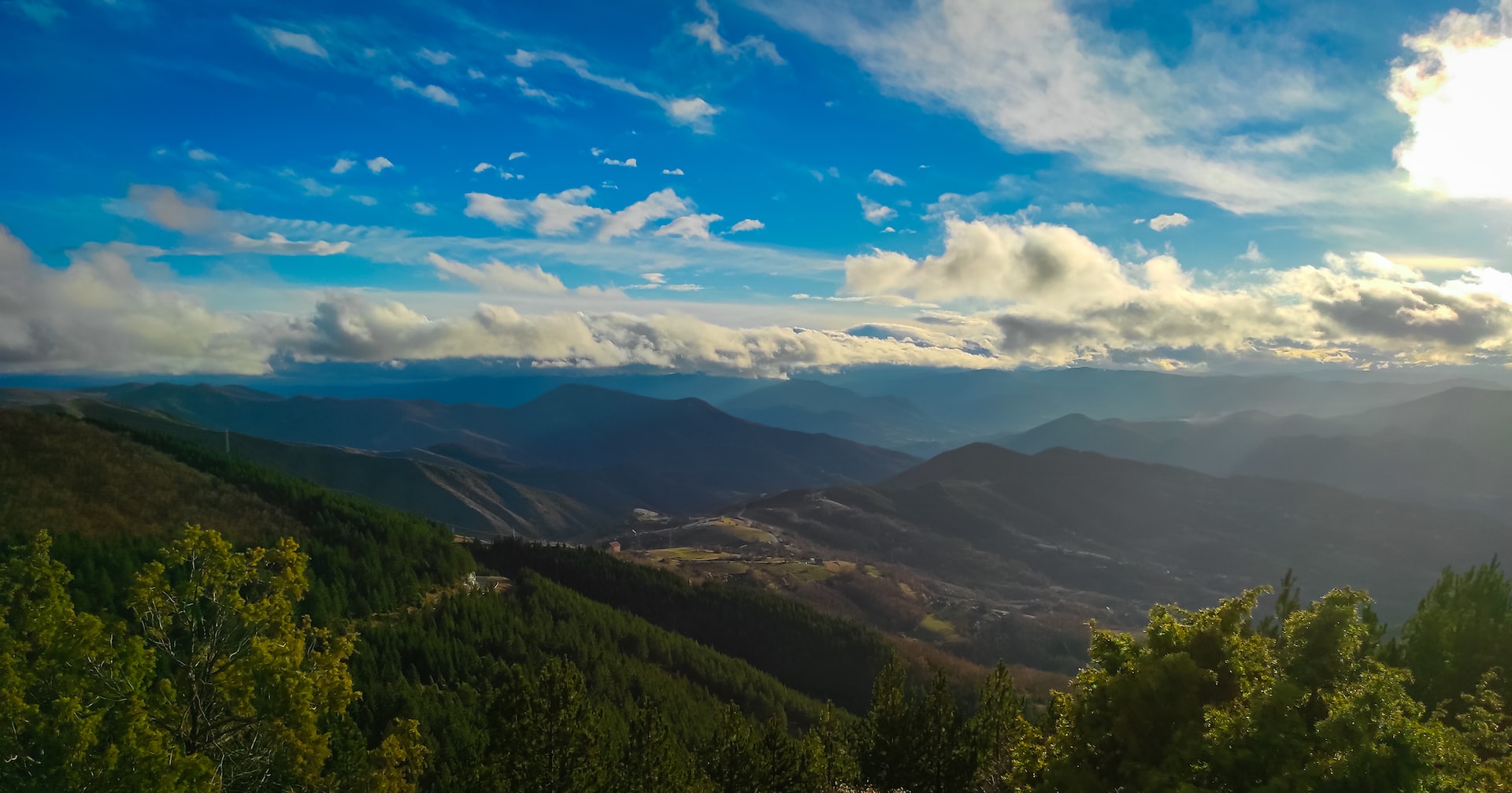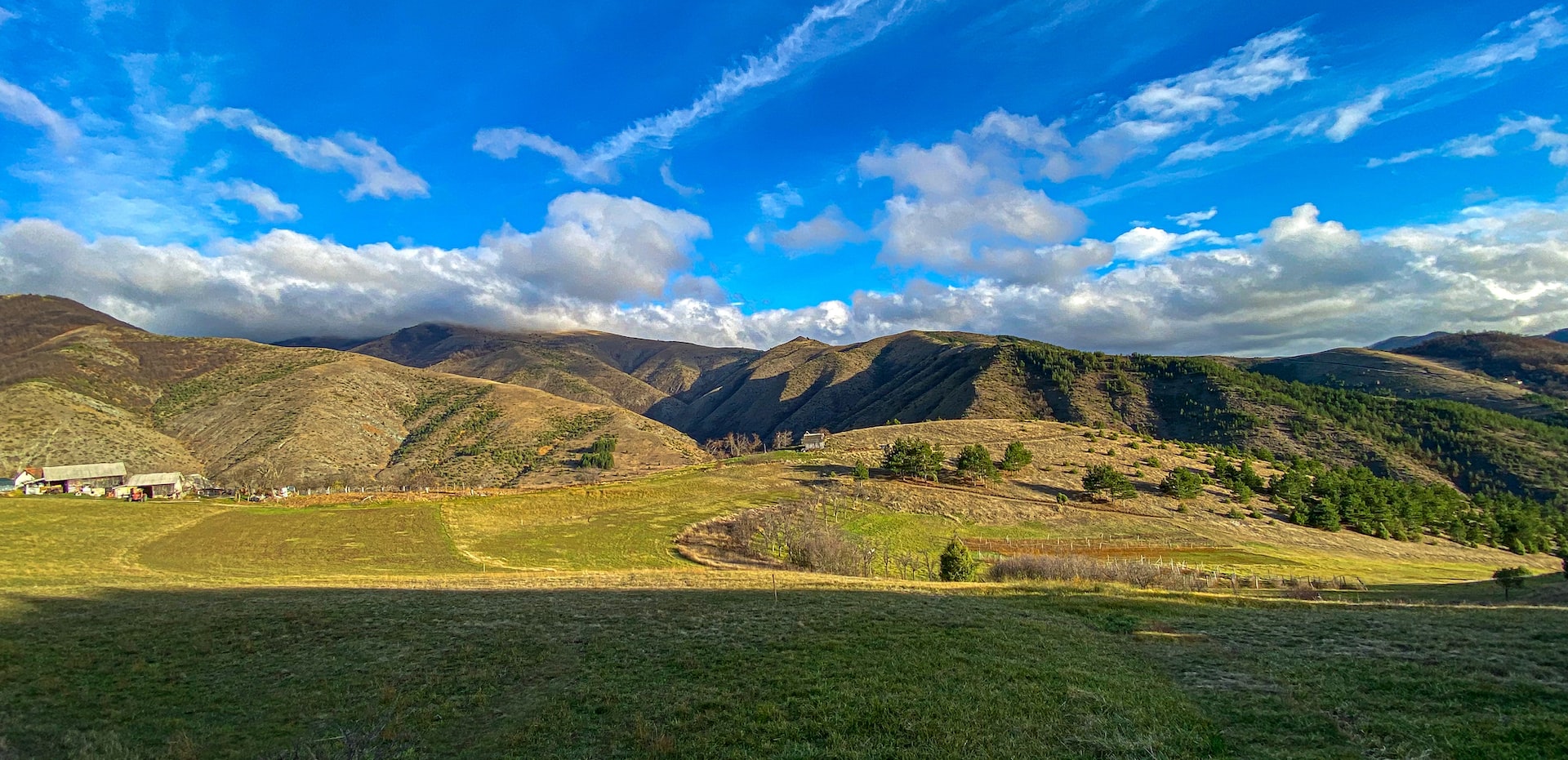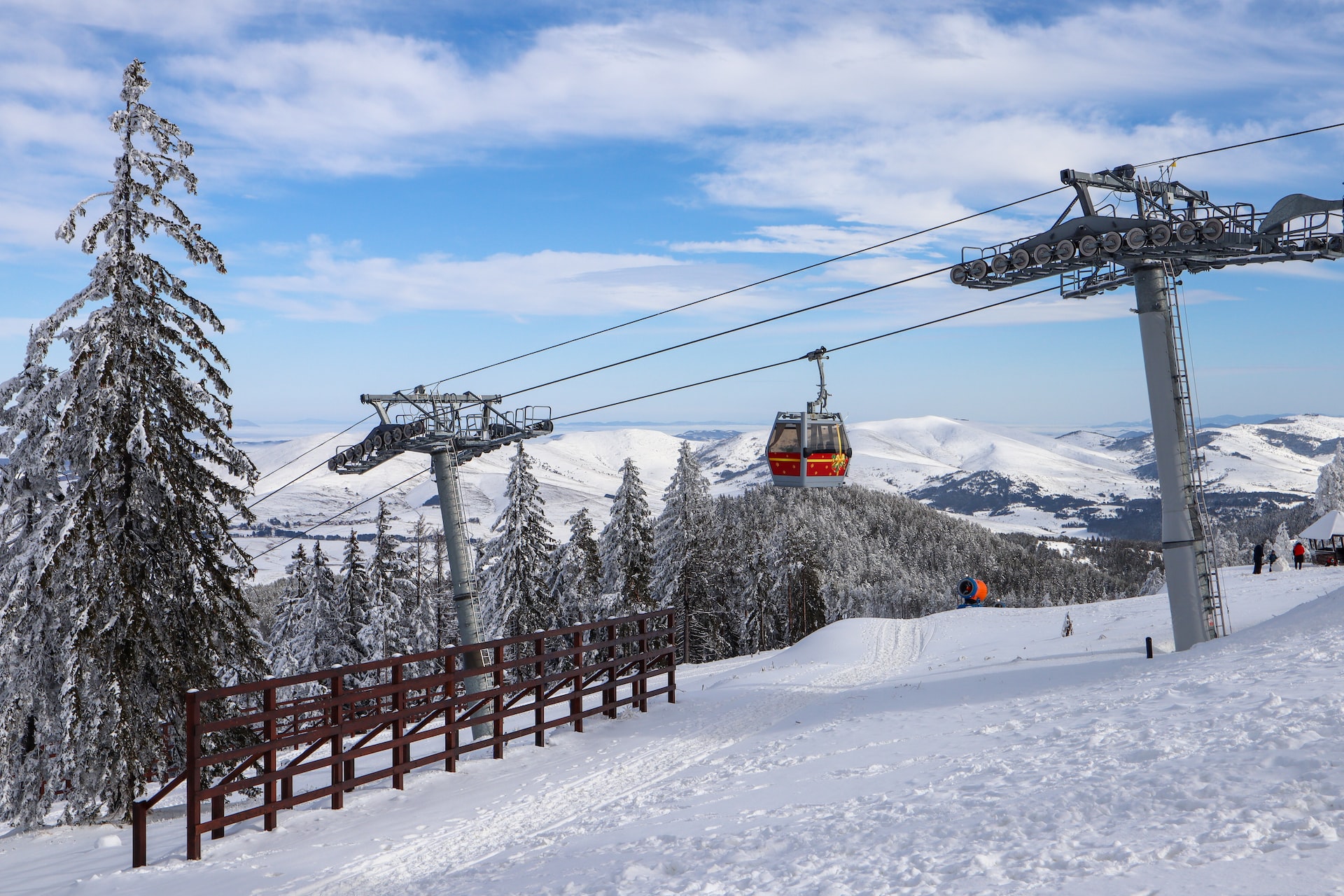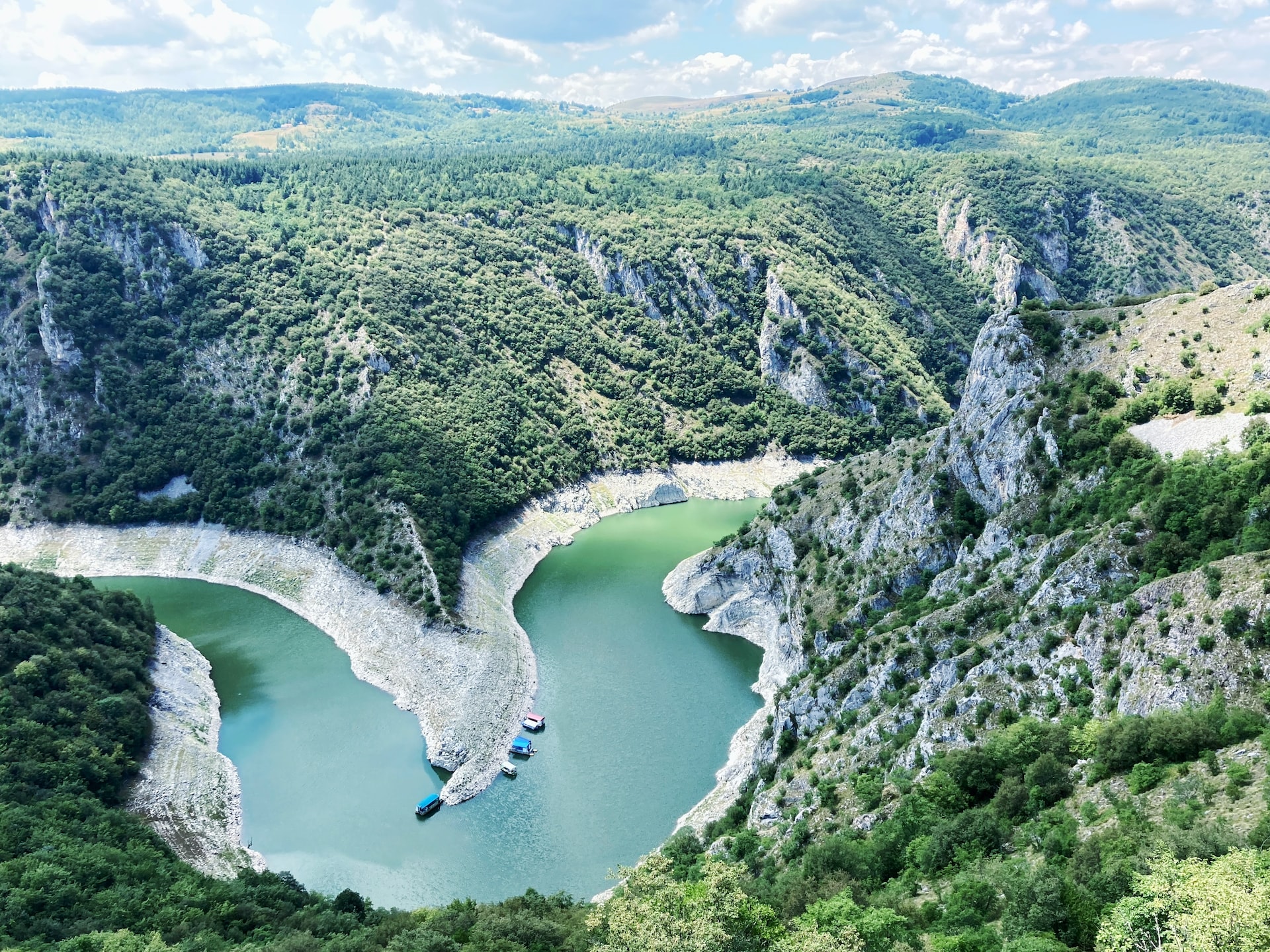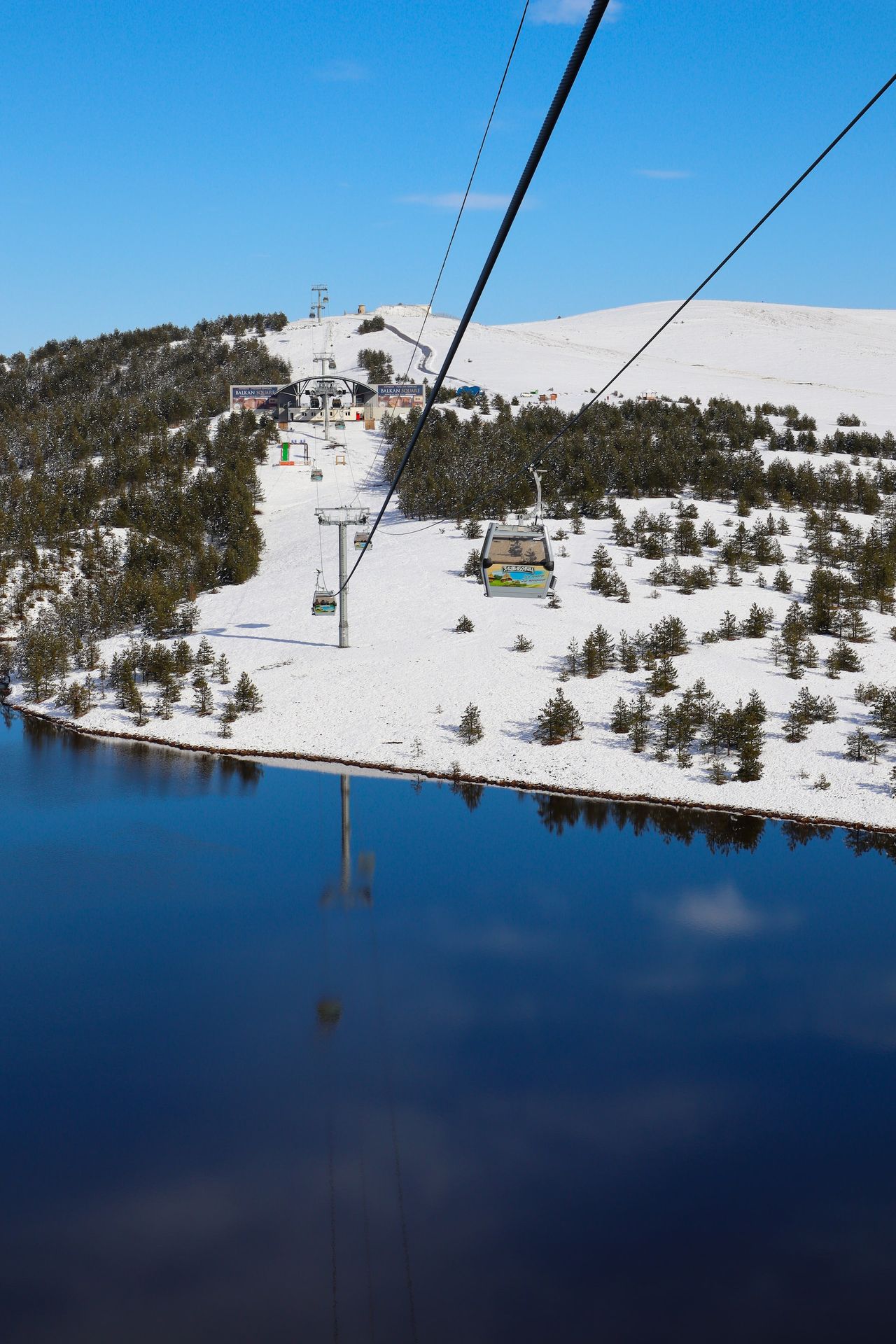Serbia, with its total area of 88,361 square kilometers, is located in Central Europe, in the southern part of the Pannonian Plain and central Balkans. It borders 8 countries and is known for its picturesque scenery, beautiful plains, and crystal clear rivers. The Dinaric Alps and Balkan Mountains make up attractive mountainous destinations for many tourists and nature lovers.
Mountains occupy the southern part of the country stretching to the west and north. The most ancient mountain range is the Rilo-Rhodope mountain system. The highest peak is Djeravica with a height of 2,656 meters.
There are 5 large national parks and many smaller nature reserves in this country. If you want to enjoy the tranquility and beauty of pristine nature and get to know more about the history, visit Serbia. Here are the most popular and attractive tourist destinations.
Djerdap National Park
The longest and most beautiful gorge in Europe is located in eastern Serbia. It is known as the Iron Gorge and the entrance to it is called the Iron Gates. It stretches for 100 kilometers along the Danube flow course on the border with Romania. It is the center of Djerdap National Park that stretches from the Golubac Fortress to the dam near Novi Sip. It covers an area of 63,786.5 hectares. The park was established in 1974. A wide area of it was designated as the UNESCO global geopark with the Iron Gates Gorge in it in July 2020. Its total area is 1,330 square kilometers.
The beauty of the park attracts the attention of many visitors. They are coming here to enjoy the picturesque scenery from the high viewpoints. The best viewpoint is Veliki Strbac. It opens the magnificent pictures of the narrowest part of the Danube known as Mali Kazan. Another viewpoint is called Mali Strbac, and it is located at a distance of two kilometers fromVeliki Strbac. You will have a view of the entire gorge from there. Many visitors also come to Kovilovo. It is the lowest viewpoint. You can admire the scenery of Porecko Island from there that can be seen when the Danube water is low.
Many rare bird species inhabit the area. You can see the black stock, the golden eagle, the gray heron, and other eagle species here.
You can take a tour around Djerdap. There are three ways to do that. You can opt for sailing on the Danube, driving along the main road, or walking about the most attractive places and enjoy natural beauty. You can also choose the EuroVelo cycling route that goes along the Danube course and connects the Black Sea and the Atlantic Coast.
There are many hiking trails in the park that differ in their level of difficulty and length. The most well-known of them is the Gold Lake trail. You can also rent a car from the administration in the park to travel around.
Djerdap has a very rich and ancient history. You can visit the Lepenski Vir archaeological site to learn more about the Neolithic civilization. It is the oldest discovered urban settlement in Europe founded in 7000 BC.
If you are fond of history, you can continue your research by going to see Tabula Traiana. There, you will see the remains of Trajan’s Bridge that was erected in the 2nd century CE by the Roman emperor Trajan. It was from here where the Roman army marched across the Danube to conquer the Dacians. You can also see the Golubac Fortress built in the 14th century located at the very entrance to the Djerdap Gorge.
How to Get There
Djerdap National Park is easily accessible. The best way to do it is going to the east from Belgrade in your own car. The trip will take you about 2 hours. The spectacular scenery on the road will make you feel excited and relaxed. You can also take a train or bus from Belgrade, too.
Where to stay
Accommodation options in the Park include Donji Milanovac and Golubac.
Tara National Park
Tara National Park is located in the western part of Serbia. The area includes medium-height mountains with the average altitude of 1,000-1,200 meters above sea level. The highest peak is Kozij Rid with a height of 1,591 meters. The park is bounded by the Drina River and located between Bajina Basta and Visegrad.
The total area is 220 square kilometers covered with forests, waterways, and picturesque slopes that provide rewarding views. The park was established in 1981.
The other well-known mountains that attract mountain hikers here are Tara and Zvijezda. They are parts of the Dinaric Alps.
You will get a perfect opportunity to admire the natural beauty and historical landmarks here. The magnificence of the park owes a lot to the rivers of Derventa, Raca, Brusnica, and Drina. The coniferous woods on their banks will impress you the very moment you arrive here. It is one of the most densely forested areas in Europe.
The Serbian spruce is the most famous plant species because it is a living fossil that survived the Great Ice Age. The park is also famous for its variety of mushroom species - there are about two hundred of them here.
You can enjoy the beauty of nature from the most popular viewpoints: Banjiska Stena and Biljeska Stena that offer magnificent views of Lake Perucac and the canyon of the Drina River. You may also go to the Crnjeskovo viewpoint where you will see the Raca Monastery and enjoy the tranquility made by centuries.
The Oslusa viewpoint will offer you the best opportunities for paragliders. You will see them taking to the sky or probably would like to try this experience yourself. You can also climb a 12-meter watchtower at the Sjenič viewpoint to see the highest mountain peaks of the area.
There are about 300 kilometers of alpine trails in the park, so Tara is a paradise for mountain hikers. The routes are of different categories and difficulty levels: from “European E7 Trail - Tara National Park” almost 60 kilometers long to “Mitrovac-Perućac viewpoint tour - Tara National Park” with only 20 kilometers so you should be very attentive while choosing one.
You can also go cycling in the Tara National Park. Cycling trails are also well-developed and accessible all year round. The most challenging of them is the Visoka Gora trail with several difficult uphill parts.
Raca Monastery is a famous historical and cultural landmark in the park and one of the most recommended places to visit. It was built in the 13th century. The Serbian alphabet was founded here. The necropolis of the monastery became a UNESCO World Heritage Site in 2016. You can also visit the WWII memorial of Borovo Brdo if you are a history fan.
How to Get There
After you have finished with what to visit in Belgrade, drive 200 kilometers southwest via extremely beautiful mountains between Valjevo & Bajina Basta. There is another option to get there from Belgrade - via the city of Loznica and then 2 hours driving along the beautiful Drina river’s gorge. You can also fly to Sarajevo in Bosnia and Herzegovina and then drive to the park from there.
Where to stay
We strongly recommend spending at least 1 night in the park or near it in Perucac, Bajina Basta, and Kremna.
Fruska Gora National Park
Fruska Gora National park is located around the biggest and most stretched mountain in Vojvodina province, not far from Novi Sad. It is considered an ancient island in the former Pannonian Sea and stretches for 80 kilometers.
The area became one of the 5 national parks in Serbia in 1960 and it is a unique region. Fruska Gora mountain is about 90 million years old, so it is the best place to discover the geological past of the Earth. Many animal fossils were found on the mountain. The name ‘Fruska’ comes from ‘Frug’, the Slavonic name of an old Germanic tribe, Franks. So, the name of the place can be translated as ‘The Mountain of Franks’.
The park is a well-appreciated picnicking destination for locals. They escape here from the hassle of urban life.
The area is rich in diverse species of plants and animals. Many of them are rare and included in the Red List of Threatened Species. There are more than 30 orchid species growing here. Rare birds, such as the eastern imperial eagle also come here to breed.
The park is a great place for hikers. There are 19 trails that attract hundreds of travelers every year. It is also a favorite among cyclists and mountaineers. The routes range from easy to difficult ones. There are many other activities here: rafting, fishing, mountain biking, etc. You can stop on the road for a picnic because there are a lot of picnic sites there.
Or you just come here to relax, laze in the sun, and breathe the alpine air. The local restaurants will offer you a lot of delicacies from the national cuisine.
The ancient Romans called this place the ‘Fertile Hill’. Vines have been grown here from the times immemorial. The supreme wines are produced here, or you may want to taste bermet that is specific to this area and made of the mixture of wine and aromatic herbs.
Honey is a local speciality too. There are a lot of hives, and the natural honey always makes life sweeter for all tourists who come here to enjoy the natural beauty.
The area features a lot of monasteries built here in the 15th-18th centuries. The Orthodox monasteries of Krusedol, Jasak, Vrdnik, and others are a special tourist destination. You can also see ancient necropolises, fortresses, prehistoric remains, and Roman roads in the area. Vrdnik Tower and Petrovaradin Fortress are the most famous of them. The lush nature provided a perfect shelter for these ancient gems during WWII, so they are well-preserved.
How to Get There
Fruška Gora is the most accessible of all national parks in Serbia. It’s an easy 1-hour drive from Belgrade, much of which is on the E70 highway. Because of that, this is one of the best day trips from Belgrade. Consider visiting this peaceful region when staying in the Serbian capital! Since it lies at the doorstep of Novi Sad, that city is a fantastic base to explore the region. The heart of the park is less than 25 kilometers and only 30 minutes from the Novi Sad city center.
Kopaonik National Park
Kopaonik National Park is a part of the Kopaonik mountain range that stretches across Serbia and Kosovo. It covers an area of 121,06 square kilometers and was declared a national reserve in 1981. Its highest point is the Pancic’s Peak with a height of 2,017 meters above sea level.
It is located in the central part of Serbia. About 689 hectares of the area is under special protection due to its diversity of plant and animal species.
The name of Kopaonik relates to the abundance of natural resources. The area is rich in zinc, lead, iron, silver, and gold. Mount Kopaonik is a big ski resort in Serbia. It attracts tourists from all over Europe. The peaks are covered with snow from November to May. Though, it is also a very popular tourist summer destination.
More than a thousand plant species grow in the area, including the houseleek, Kopaonik violet, and Pancic’s bittercress. There are also hundreds of animal species, endemic butterflies, and birds. The area is also famous for its mushroom diversity. Over two hundred mushroom species grow here, such as oyster mushrooms, parasol, true morel, chanterelles, and penny buns.
You can go on hiking tours and pick local herbs and fruits on the road. Hiking trails are also diverse in their levels of difficulty. Markova Stena and Duboka are the easiest of them. The Seats of heaven is the most difficult one. Josif Pancic is the longest trail that will bring you to the highest point of Mount Kopaonik.
You can also spend a day on the Kadijevic picnic site and enjoy the magnificence of thick coniferous forests that grow along the Samokovka River. If you prefer cycling or mountaineering, you can opt for the Red, Orange, and Green Borje routes. They are different in difficulty but all of them are stunning and impressive.
The Samokovsko River is famous for its numerous waterfalls. The Zaplaninska River that flows underneath Pancic’s Peak features a great multi-step waterfall of Jelovarnik. It is the highest water drop in Serbia.
There are also several picturesque lakes here. The round Semetes Lake is crystal clear and, owing to many underground springs, the level of water in it never drops. If you are striving for the healing effects of spa resorts, Lukovska Banja and Josanicka Banja spas are waiting for you.
The most popular natural sites here are White Rocks, where gray falcons nest, and the Duboka nature reserve. There are many other stunning natural landmarks that are worth visiting. You can also go to the Large Rock site to admire the beauty of gorgeous mountains.
Tourists coming to the Kopaonik National Park can visit the nearby monasteries of Studenica or Gradac built in the 12th-13th centuries. The medieval city of Maglic was built in the 13th century on the cliffs over the Ibar River. It can be spotted from a distance because it is hardly accessible nowadays. Veliko Metode is a 3rd century church built inside the rock that is worth visiting too.
How to Get There
Kopaonik is a top winter ski resort, so it is easily accessible from any part of the country. You can drive there from Belgrade, and it will take you about 4 hours. Or you fly to the nearest airport in Nis and then drive less than 3 hours.
Where to stay
Choose any of 750+ accommodation options in Kopaonik with a 9.5+ rating here.
Uvac Special Nature Reserve
Uvac Lake is famous for its crystal clear waters. You can visit the Uvac Special Nature Reserve and the area around to forget about all your everyday issues and relax. The rivers of Zlatibor and Zlatar are characterized by deep riverbeds and canyons. The Uvac River flows around Zlatibor Mountain, and it is the main tributary of the Lim.
The special natural reserve formed here is located in the municipalities of Nova Varos and Sjenica. It covers the territory of 7,543 acres, and its highest point is 1,322 meters above sea level.
Apart from the rivers, the reserve also includes three artificial lakes - Uvac Lake, Radoinja Lake, and Zlatar Lake. The Uvac canyon is inaccessible, so it makes an ideal natural dam and a secure place for many monasteries that were built there centuries ago. You can visit Uvac and Dubrava Monasteries there.
The natural reserve status was received by the area due to a wide variety of plant and animal species. The most famous of them is the griffon vulture that was about to go extinct. Nowadays, there are about 300 of them on the territory of the reserve. There are more than 140 other unique bird species here. The golden eagle is also pretty rare and endangered. You can also encounter the owl and kingfisher here. There are many bats in the caves, and otters inhabit the water basins.
Due to the extended cave system in the valley of Uvac that stretches for more than 100 kilometers, the reserve is one of the most beautiful areas in Serbia that is really worth visiting.
How to Get There
You can settle in Zlatibor to explore the reserve as it is only a 1-hour ride. There are guided tours there or you just drive your own car to admire the natural beauties. The reserve is also accessible from Belgrade by taxis, buses, or driving the car for rent.
Where to stay
The nearest town to spend a night is Novi Pazar.
Final Thoughts
The natural beauties of the Serbia National Parks attract a lot of tourists from Europe and overseas every year. If you want to become one of them, love nature and adventures, want to experience the unforgettable travel emotions, visit this beautiful country and discover it for yourself. You will be pleasantly surprised!

